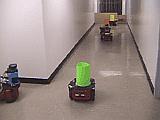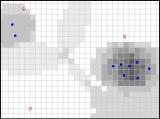|
Target Tracking with Mobile Robots
|
|---|
|
|
Motion Tracking from a Mobile Robot
|
|---|

|
Robust detection of moving objects from a mobile
robot is not easily achievable since there are two
motions involved: the motions of moving objects and
the motion of the sensors used to detect the
objects. We have experimented with a probabilistic
approach for moving object detection from a mobile
robot using a single camera in outdoor
environments. The ego-motion of the camera is
compensated using corresponding feature sets and
outlier detection, and the positions of moving
objects are estimated using adaptive particle
filters.
Click here for more details.
|
|
|
|
Region-based Approach: Multi-target Tracking with Multiple Robots
|
|---|

|
The problem of tracking multiple targets using a
network of communicating robots and stationary
sensors is addressed. We introduce a
Region-based Approach which controls robot
deployment at two levels. A coarse deployment
controller distributes robots across regions using
a topological map which maintains urgency estimates
for each region, and a target-following controller
attempts to maximize the number of tracked targets
within a region.
Click here for more details.
|
|
|
|
Generalized Region-based Approach: Extension to Unstructured Environments
|
|---|

|
The multi-target tracking problem is re-visited;
the Region-based Approach is extended
for unstructured, outdoor environments. In this
approach each robot constructs virtual regions
based on the latest tracking information from other
robots. Without pre-partitioned region
information, each robot independently estimates the
most urgent region that needs to be visited. A
multi-robot system to track moving objects outdoors
has been designed using this approach in order to
validate the idea.
Detailed description is not available on the web yet.
Refer to relavant papers
for more details.
|
|
|
|

